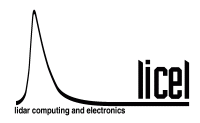The header lines (ASCII format) have a length of at least 80 characters, where the two
last characters are <CRLF>. The header lines are followed by
the data in binary format. The first header line contains the filename,
- which begins with one or two letters
- two digits showing the years in the century
- the month (hexadecimal, one digit)
- the day (decimal, two digits)
- the hour (decimal, 24 hours per day, two digits)
- a period (.)
- the minute (decimal, two digits)
- the seconds (decimal, two digits)
- two or three decimal places of the seconds (decimal, two or three digits).
The second header line contains information about the system:
- measurement site (8 characters)
- measurement start time (dd/mm/YYYY HH:MM:SS)
- measurement finish (dd/mm/YYYY HH:MM:SS)
- the altitude above sea level (four digits (meter))
- the longitude (11 digits (including - sign), six decimal places)
- the latitude (11 digits (including - sign), six decimal places)
- the zenith angle (four digits in degrees), one decimal place)
- the azimuth angle (four digits in degrees), one decimal place)
- a custom information field enclosed by quotation marks ("") [optional]
In the third header line
- the number of laser shots of the type 1 laser (integer 7 digits)
- the repetition rate of the Type 1 laser (integer 4 digits)
- the number of laser shots of the type 2 laser (integer 7 digits)
- the repetition rate of the Type 2 laser (integer 4 digits)
- the number of the following data sets (integer 2 digits) are given
- the number of laser shots of the type 3 laser (integer 7 digits)
- the repetition rate of the Type 3 laser (integer 4 digits)
- 0000000 0000 (reserved)
- the controller timestamp corresponding to the data [optional]
The header lines specific to the data sets contain:
- data set active (
1|0). Non-active data sets will not be written. - data set type.
0Analog,1Photon Counting,2Analog squared,3Photon Counting squared,4Power Meter dataset,5Overflow dataset - laser (
1|2|3|4) - number of data points (5 digits)
- the laser polarization 0 (none, vertical, horizontal, right circular, left circular)
0|1|2|3|4 - High voltage of the PM (V) (four digits in Volt)
- bin width (in meters four digits including decimal separator (.) and decimal places)
- wavelength (nm) in nm, five digits followed by a period (.)
- polarization status (none, parallel, crossed, right circular, left circular)
o|p|s|r|l 0 0(backward compatibility)- bin shift, whole-number (primary bins, integer rounded down, 2 digits,
00if not supported or zero) - decimal places of the bin shift (3 digits,
000if not supported or zero) - the number of bits of the ADC (2 digits)
- the number of shots (6 digits)
- discriminator level or data range of the ADC (one digit period
4/3digits) - device identificator
(The number is the address of the transient recorder or the power meter controller and detector indices as a hexadecimal number)BTanalog dataset BCphoton counting S2As sqrt(N(N-1))(analog,ssample standard deviation,Nshots)S2Ps sqrt(N(N-1))(photon counting,ssample standard deviation,Nshots)PDpowermeter (photodiode) PMpowermeter (powermeter) OFoverflow - a custom information field enclosed by quotation marks ("") [optional]. If a transient recorder channel is assigned to a detector
<detectorID: detector description\textgreater>will be part of the custom info field which is always present in that case.
Each line of the header is completed with a carriage return and a line feed 0x0D0A (CRLF).
The header lines are followed by the 32 bit data sets. A data set is an array of 32bit wide unsigned integer values saved as little endian. Each data set is introduced by a <CRLF>.
After the last data set a final <CRLF> follows.
The data sets can be converted to quantities with physical
units by using the number of shots and additionally the number of bits and the data range in case of
the analog signal. This procedure is executed e.g. in Advanced Viewer.exe. Please refer to http://www.licel.com/manuals/programmingManual.pdf#subsection.5.3 for the conversion of raw data to physical values.
The overflow data set contains bitwise information whether or not an overflow appeared in a range bin of an analog dataset. For the first analog dataset in an acquisition bit0 (= 1) will be set, for the second bit1 (= 2) is set, and so on. E.g. a decimal value of 3 (binary 11)in a certain range bin indicates that the first and the second analog dataset of the acquisition have an overflow.
Back to index
